Braving inhuman humidity for the love of 8 bits.
This year I got talked into attending KansasFest for the first time ever. To be fair, my arm didn’t require very much twisting. I’d been hearing about this event for a number of years, and had been thinking about going, but never quite pulled the trigger until now. I packed up my things and headed off to Missouri, the land where all of the humidity in the galaxy apparently goes to hang out. If you ever wondered what it’s like to walk around in an infinitely deep hot tub while somehow not drowning, Missouri in July is the place for you.
This isn’t a Hack per se, but I wanted to do a post about it here, because if you read my blog, then you should be at KFest. It’s pretty much the premiere annual event for retrocomputing enthusiasts. While it is focused on the Apple ][ (the computers that Apple made for a decade before “Macintosh” was a thing), there are people there of many different persuasions (even, gasp, Commodore!).
I wasn’t sure what to expect from KFest, but I’m here to tell you that what I found were some of the most epic hacks by the coolest people you can imagine. It was, in a word, amazeballs. I can’t hope to cover every incredible thing I saw and learned while there, but I hope to hit a few highlights.
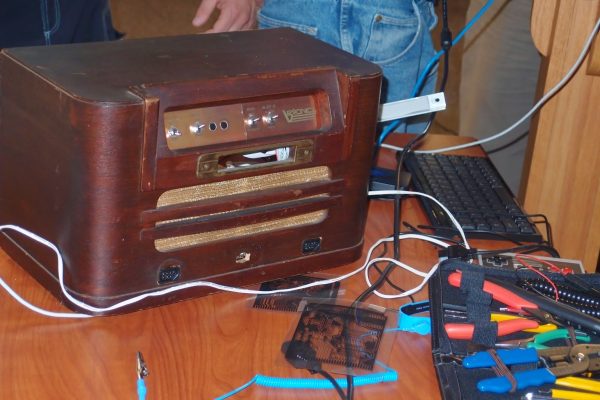
The most obvious highlight for me personally was that I brought along Veronica and gave a presentation all about her. I wasn’t sure if people would like this weird 6502 box that sort of doesn’t do a whole lot. I wasn’t sure if I could cart it across the country through airports and planes and taxis and rideshares and have it still work. I wasn’t sure if anyone would be interested in the story behind it all. All of that uncertainty was very pleasantly unfounded. KansasFest liked Veronica almost as much as I like KansasFest. This was the perfect crowd to appreciate a home-brew 6502 computer, and little Veronica was very well received.
The second big highlight for me was the Garage Giveaway. That’s where everyone brings out their old Apple ][ hardware and puts it on a big table for people to take. The deal is, it’s all free, but it has to stay in the community. In other words, none of it had better show up on eBay a week later. The intent is to get hardware out of the storage sheds and into the hands of people who will do something cool with it. Donations are also appreciated, as there are some key people providing most of the gear and doing a lot of work to get it there. I scored a particularly sweet prize.
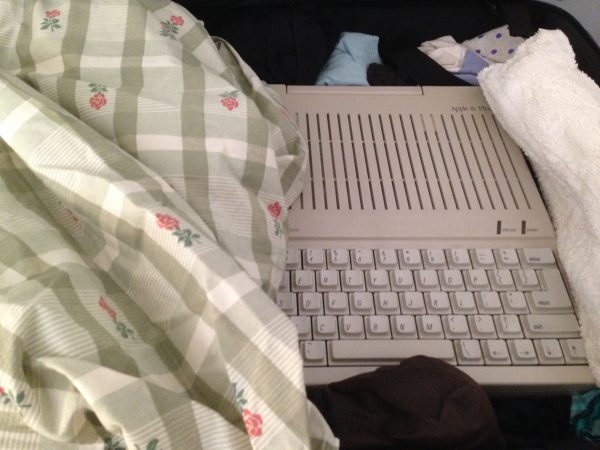
For those who aren’t familiar, that lovely specimen is an Apple //c+. It’s a bit of an odd duck in the Apple ][ line, and that’s why I like it. It’s a later revision of the very popular Apple //c. However, it has a much-maligned 3.5″ drive in it (a format which virtually no 8-bit Apple ][ software ever shipped on), and it has some different connector types than a normal //c. On the plus side (nyuk nyuk), they licensed the Zip Chip technology for it, which was an aftermarket accelerator system for Apple ][s. This version can go up to 4MHz. That sounds like nothing today, of course, but consider the software was written to be fast and smooth at 1MHz. So, imagine your current PC or Mac running at 8-12 GHz. That’s what this is like. The other major change over the //c is they moved the entire power supply internal. The original //c has a lumbering external power brick that resembles the one from a Commodore 64 or an Xbox 360. This change is also controversial, because while it’s convenient, it means you no longer have direct access to the power supply of the motherboard, which allowed easy interfacing to other power standards (or even batteries). Nevertheless, the //c+ is a really lust-worthy machine to me, so I’m beyond thrilled that the KFest community coughed this one up and it landed in my suitcase.
Next up are the sessions. Oh, the sessions. Anybody who wants to gets up and gives a talk about something cool they did with an Apple ][ (or other retrocomputing-related stuff). There are so many of these that the sessions run from about 9am to midnight every day for the entire six day conference. If you’re planning to get some sleep on your vacation, KFest is not the fest for you. I’ll hit a few of my favorites here.
First up is A2Cloud and A2Server. This is a collection of tools that allows an Apple ][ to interact with a Raspberry Pi in a number of amazing and powerful ways. You can connect to the internet, you can use shared file stores, you can even net boot. At one point, the creator demonstrated the tech by net booting an Apple IIgs over wifi from a file store hosted on a battery-powered Raspberry Pi. The machine appeared to be booting off of thin air. A parlor trick, sure, but the underlying tech is genuinely useful. For example, this means you can do cross-platform development using a git repository hosted on a un*x box. Or, you can develop on a common code base that can be simultaneously tested in a local emulator and remotely on real Apple ][ hardware. These are just a few examples of what this system is capable of. During his presentation, the creator sent a disk image of a game from his Apple ][ to everyone in the audience. With a few clicks, we were all running it in our own emulators.
Another favorite of mine was the presentation on Lawless Legends. This is a 2.5D ray-casting first-person engine for roleplaying games, being built for the Apple ][ and Commodore-64. You read that correctly- a high-resolution ray casting engine running on a 1Mhz 8-bit machine, at interactive frame rates. Until I saw this (and played it) myself, I would not have thought it plausible to attempt. Beyond just the eye candy, however, this team is building a full and proper AAA-style game engine. There’s a map editor, a scripting language, event triggers, data-driven scenarios, and it’s all open source. Terrific, terrific work.
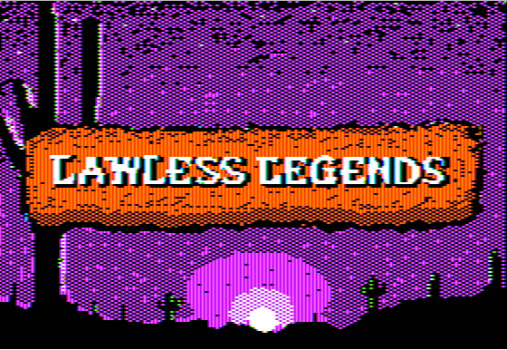
It’s not all about chips and opcodes. Sarah Walkowiak put on an excellent crafting session where we all got to learn how to make plastic-canvas-backed 3D cross-stitch ornaments. We made little models of Apple //e computers, of course, complete with Duo Disks and (proper) multicolor Apple logos on the screen. If you’d like to make your own, she’s shared the patterns as a PDF here.

Circling back to my new toy for a moment, there was a session on overclocking the //c+. It’s a great example of the depth of knowledge of this community. It turns out there’s a certain combination of ASICs and motherboard versions that can be overlocked up to 10MHz (or more?). Even better, if you have one that can’t be overlocked, a socketed chip can be swapped with another machine that makes BOTH machines overclockable. I know, it’s nutty, but it’s true. The exact reasons for all this are a bit murky to me, as I was busy doing other repairs on my //c+ at the time. I’ll be revisiting this overclocking process at some point, though. Speaking of which, watch this site for many hacks to come involving my beloved new family member.
The keynote presentation has been given by various luminaries from ’80s computing over the years, including Steve Wozniak himself on one occasion. This year we were treated to Margot Comstock, co-founder of SoftTalk magazine. She had many interesting behind-the-scenes stories from the industry, and seeing a young Bill Budge posing anonymously in a feature photo generated lots of laughs.
Often times, great sessions would come out of left field (for me, anyway). One young fellow gave a presentation on a group of Japanese users who had hacked GS/OS to work in Japanese. They came up with fonts, an input system, and various other details to make it all (sort of) work on a machine that was never intended to leave the US. The presenter has picked up their work 25 years later, and is building on it. He’s gone so far as to recompile significant portions of the OS from source in order to incorporate new localization tools for Japanese. It was impressive work, and not something I would have ever guessed people would be doing. The passion of the retrocomputing (and Apple ][) community is boundless.
The hands-on workshops are very popular. Vince Briel always comes with a bunch of his amazing retrocomputing kits, and people build them on site. It’s a great way to learn to solder, and when you’re done you have a neat new toy to play with.
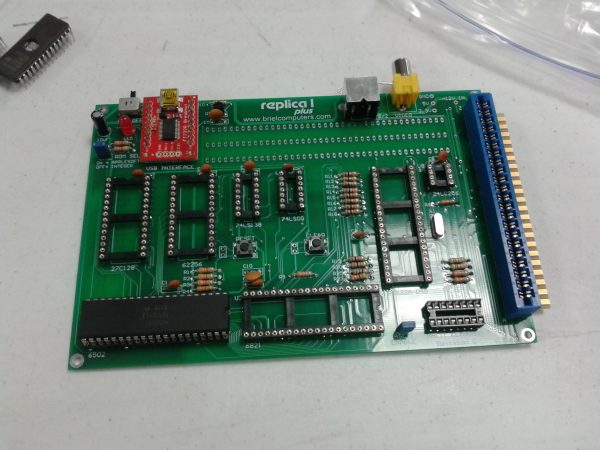
There’s a big archiving push taking place right now in retrocomputing circles. If you’re under 30, you may not have ever used floppy disks yourself, but hopefully you are at least familiar with them. What you may not realize is that they are not permanent storage. The magnetic media degrades over time, and floppies the world over are dying. In fact, their projected lifespan is roughly now-ish. This is a tough problem to solve, because most of this software is copy-protected. If it wasn’t for the software pirates and crackers of the period, we would have nothing today (a perfect argument against DRM if ever there was one). None of it would be readable in a way that it can be preserved. At KansasFest, I got to witness a very interesting new archiving effort. Using special hardware boards (like this and this) connected to original floppy drives, they are reading the actual magnetic flux information at very high resolution off the disks. It can then be processed later to try and interpret what are tracks, sectors, and bytes. This is much harder than it sounds, because copy protection back then was very aggressive. Data was sometimes stored on half or quarter tracks. Some disks used a spiral pattern. Some disks had more sectors or tracks than were technically allowed by the drives. Some relied on physical abnormalities on the disks. This is far more than a few checksums and a bit of encryption, like DRM is today. Sure, most of the games were cracked at the time and we have those, but there’s millions of software titles that the crackers didn’t bother with, because they weren’t hot new games. Without efforts like this one at KansasFest, this cultural history of software will be lost for ever in just a few years. It’s not just software, either. It’s also about the documents, the letters, the school reports, the business records, etc. If you think none of that could ever be important to preserve, go read The Diary of a Young Girl again. It’s not possible to predict what will be important cultural legacy in a hundred years, so we must preserve it all. These documents are generally in obsolete proprietary formats from long-defunct word processors and databases (an argument for open file formats, if ever there was one). If we can’t resurrect the software that created the documents, we stand a good chance of losing it all.
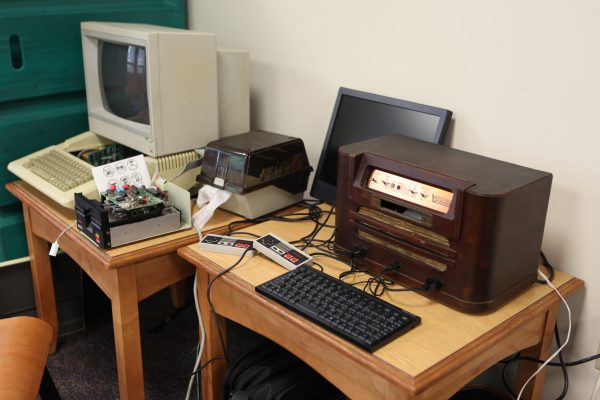
Speaking of archiving, perennial favorite Jason Scott was in attendance, as usual. He gave a talk about the great work being done over at archive.org. He’s an entertaining guy, and his passion for preserving books and digital culture is contagious.
Another crowd-favorite session was put on by a father and son team. They brought along a KNex roller coaster, an array of rocket launchers, and various other gadgets, all controlled by an Apple //e. Anything you’ve ever seen done on sites like Hack-a-Day involving Arduinos (and such) can be done even better with an Apple ][. An Apple ][ basically is an Arduino, with the addition of much better I/O, real color video, a much easier set of programming tools, and a keyboard. Oh, and yes, rockets were launched. They went whoosh into the sky and it was glorious.
The ornament-making wasn’t the only artistic component. A team from France brought in a once-thought-lost piece of interactive art created by Chris Marker in the mid 1980s. The floppy disk was recovered, and they got it working again. It’s called The Dialector, and it’s perhaps best described as a chat-bot reinterpreted as existential art piece. It was really fun to play with, and was a great example of the empowerment created by the BASIC-in-ROM of early computers. The barrier to entry for programming was so low that it could be exploited by anyone as a tool for art and culture.

Then there’s the contests! There’s HackFest (where the winner did a perfect port of the mobile game 2048 to the Apple ][), there’s the door decorating contest, there’s a game tournament, there’s Bite-The-Bag, and the list goes on.
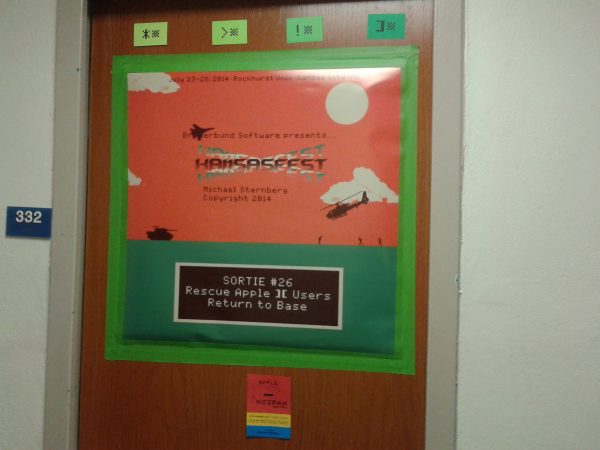
I haven’t even gotten to all the great people yet. I got to pick the brain of the fellow who built the massively-parallel-processing computer composed of Apple ][ motherboards, the Apple Crate. They were once networked through their cassette ports, but they now use the joystick ports. I got to meet all my favorite podcasters from great shows like Retrocomputing Roundtable, No Quarter, ANTIC, RetroMacCast, Floppy Days, and Drop /// Inches. Speaking of which, I got to play with a real Apple ///, a Pippin, and other rare oddities from Apple’s distant past.
And oh, the toys! There were CFFA 3000s and SID chips grafted into Apple //s. There were overlocked Transwarps heating up the whole building. There was an LCD surgically inserted into Apple //c. There was 3D printing in action. There was code that can detect an emulator from within it. There was pinball and video games. There was an exploding hard drive. There were Raspberry Pis grafted to everything except the payphone (next year). It was 8-bit madness everywhere you looked.
In a way, it’s tough to write this post, because there’s no way I can cover all the great things and all the great people. It’s impossible not to leave someone out, and to those people, I’m sorry. I loved everything I saw, everything I did, and everyone I met at KansasFest 2014. If, after reading this, you haven’t already blocked out your calendar for next year, then you are missing out and I’m taking my ball and going home.

Glad you had a good time, and scoring the //c+ was just great. I love that machine. Now all you need to do is to score a 5-1/4 drive. There’s tons of software for the //c+ that is unavailable on 3-1/2. I am already looking forward to next year as well.
Well, what I really need to do is get into my parents’ basement and get the stuff out of there. I have 5.25″ drives, an Apple ][+, an Apple IIgs, an Imagewriter II, and a Laser 128EX, among other things. Also tons of books and manuals, and two decades worth of floppies. Because of where they live and where I live, the logistics of getting that stuff out have been a barrier so far.
*DROOL HARD WITH EXTREME PREJUDICE* 8-O_____
Quinn,
Also glad you had a great time at Kansasfest. It’s now on my list of must-goto-soon list. (Mild BASIC pun there). I really wish you’d visit the right coast sometime… Vintage Computer Festival East is a blast, as is Maker Faire NYC. Now you’ve taken Veronica on the road … You can’t put that genie back in the bottle!
-Crawford
Hey, never say never, right? If Veronica makes another public appearance in the near future, it will likely be at the big Hack-A-Day event happening in Pasadena,CA in October. We shall see.